Pungent, flavourful in taste and crunchy in texture, stir-fried Napa cabbage with hot & sour sauce is one of the best ways to cook this versatile vegetable. This recipe shows you how to make it to a restaurant standard.
Napa cabbage: a versatile vegetable
Known as Big White Vegetable (Dà Bái Cài/大白菜/) in Chinese, Napa cabbage (aka Chinese cabbage) plays such an important role that an old Chinese saying claims “Bǎi Chī Bú Yàn Dà Bái Cài/百吃不厌大白菜”, meaning “One can never get tired of eating Napa cabbage”. It used to be one of the few vegetables available during winter in Northern regions of the country. So most home cooks, like my parents, master skills for cooking it in various ways. You can find it in salads, stir-fries, soups, dumplings, steamed & braised dishes, etc.
Although I love them all, my personal favourite has always been stir-fried Napa cabbage with hot & sour sauce (酸辣白菜). It’s a simple, humble dish that calls for common ingredients and requires basic stir-frying techniques. Yet, to produce it to a high standard (well-seasoned & perfectly-cooked), you’ll need to pay attention to a few important details.
How to cut Napa cabbage for stir-frying
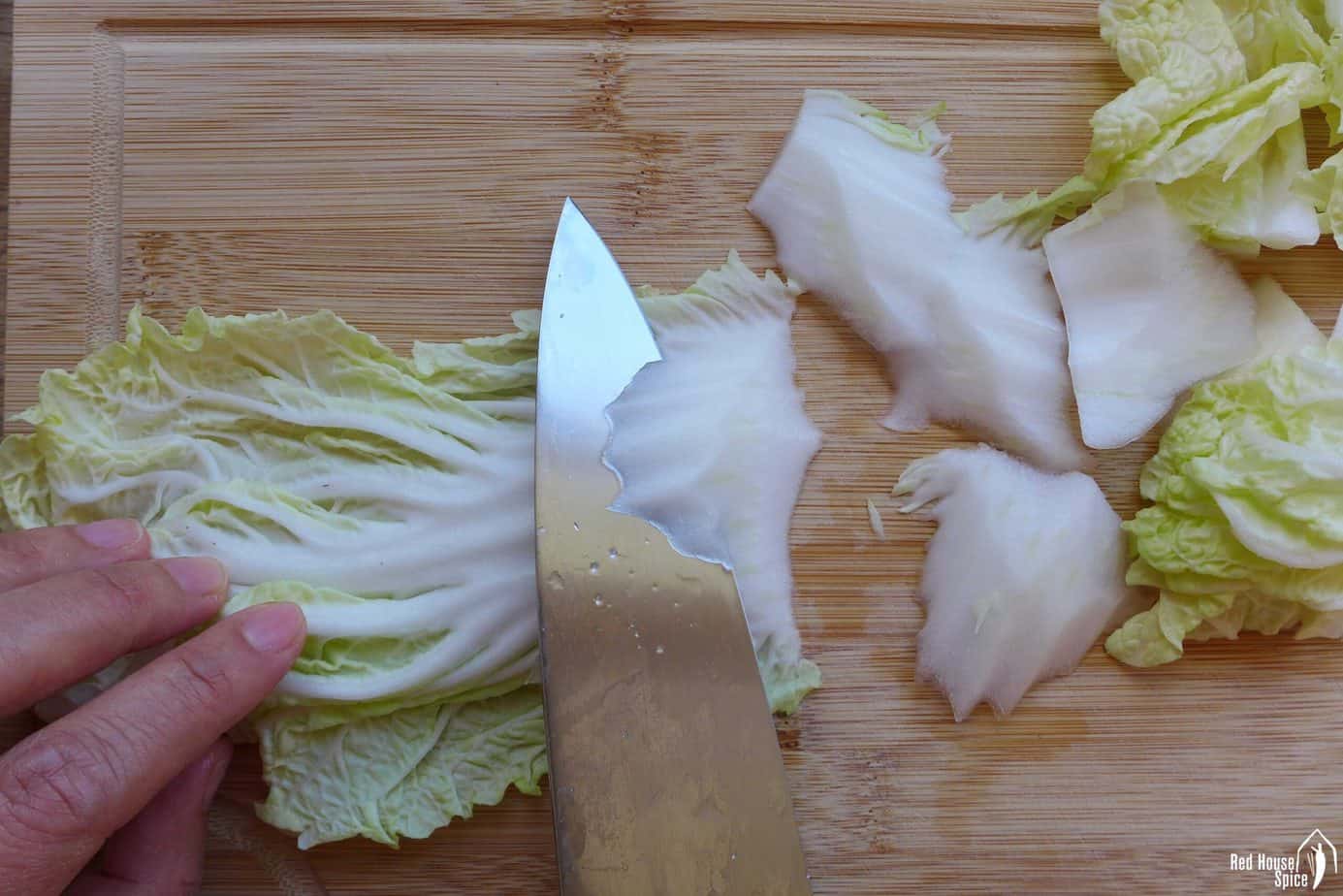
When it comes to cutting vegetables for Chinese stir-fried dishes, there are two general rules to follow: All the pieces are cut approximately the same size. This is to ensure even doneness during cooking. Cut the vegetable in a way that enables maximum surface absorption of flavours from the sauce.
For this stir-fried Napa cabbage dish, I suggest you try slicing the cabbage this way:
- Cut off the end of the cabbage (about 1cm). Separate all the leaves with your hands.
- Lay one leave flat on the chopping board. Cut it into bite-sized pieces at a 30-degree angle. Repeat to finish all the leaves.
Another tip: Make sure to drain/dry the cabbage leaves very well after washing as you wouldn’t want too much water going into the wok.
How to create the best hot & sour flavour
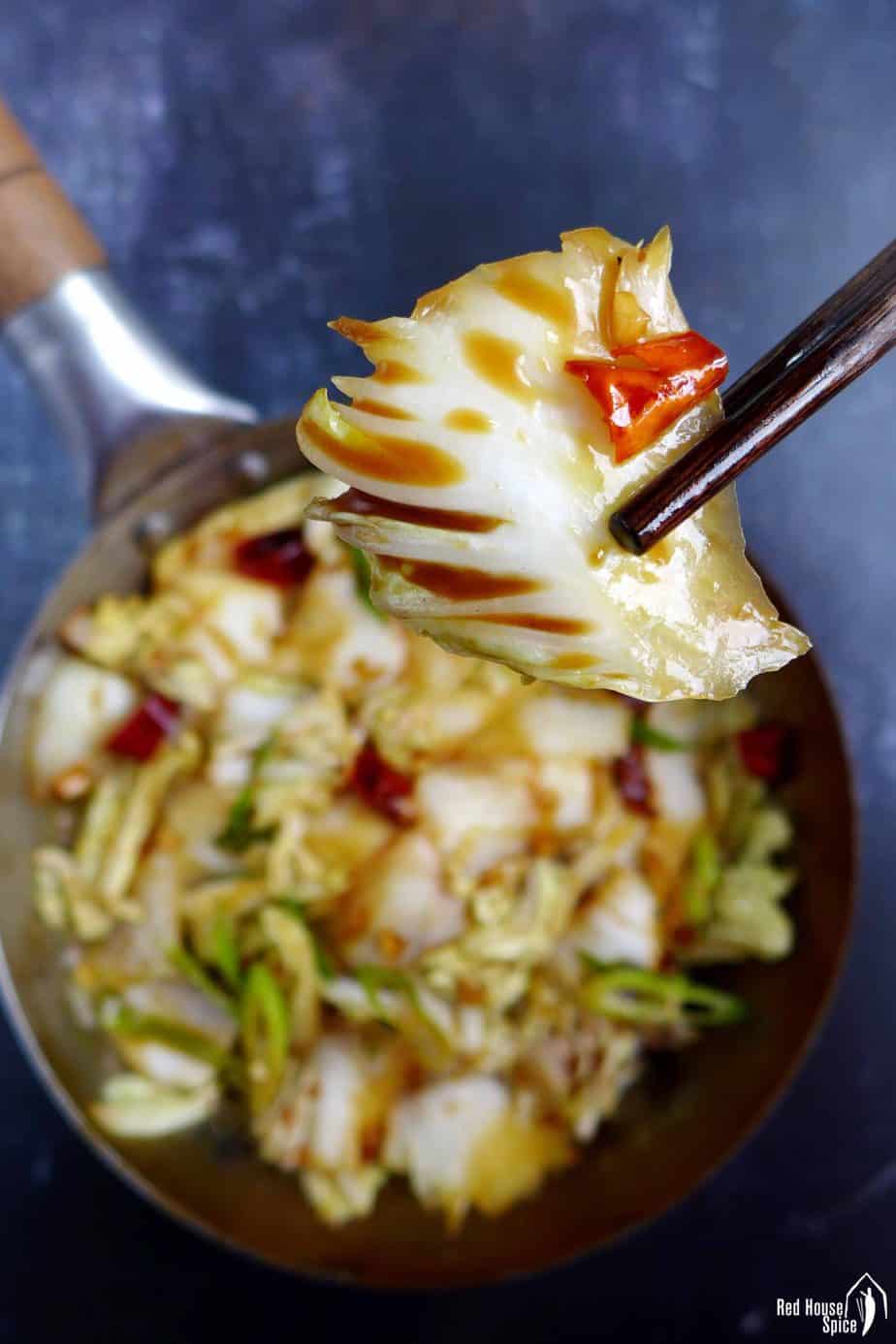
In the list of popular flavours of Chinese cuisine, hot & sour could make it to the top five, particularly for people from the North and West of China. Good hot & sour dishes not only excite your taste buds with their pungency but also leave a pleasing aroma on your palate.
The heat comes from dried chili
In different dishes, this classic flavour comes from different ingredients. The famous Hot & Sour Soup uses white pepper for spiciness. Hot & Sour Glass Noodles Soup and Hot & Sour Beef Dumpling Soup call for Chinese Chili Oil instead. In today’s Hot & Sour Napa Cabbage, which shares the same seasoning formula with Hot & Sour Potato Stir-fry, you’ll find dried chili as the heat source.
Please be aware that the suggested quantity of dried chili in the recipe is for your reference. Adjust if necessary based on the heat level of your chili and your own tolerance to spicy food. The goal is to achieve a tangy kick but the dish shouldn’t be so hot that you lose the chance to sense other flavours. If you don’t have dried chili at hand, fresh chili would work too.
Use black rice vinegar for sourness
For the sourness, all of the hot & sour dishes mentioned above use Chinese black rice vinegar. An underrated ingredient, compared to soy sauce, it’s absolutely indispensable when it comes to making authentic Chinese cuisine. As the key seasoning for this stir-fried Napa cabbage, it creates pungency as well as a rich aroma.
I’m often asked what can be used to substitute Chinese black rice vinegar. Unfortunately, there isn’t a substitute. You might have heard some people suggesting balsamic vinegar. Believe me! They’re very different in taste. Since it’s the key ingredient for today’s dish, you won’t be able to produce the authentic taste without it. For best taste, I recommend you use Zhenjiang (Chinkiang) vinegar/镇江香醋, a reputable variety widely available in Chinese stores.
Other seasonings you’ll need
Apart from dried chili and rice vinegar, you’ll also need the following ingredients:
- Soy sauce. I use a combination of two types: light soy sauce for the savoury, umami taste and dark soy sauce for its caramelised flavour and effectiveness in browning. Please feel free to skip the latter if unavailable.
- Salt & sugar. You would need just a pinch of each as other seasonings contain both.
- Starch. It’s for thickening the sauce which evenly coats the cabbage pieces. You may use either tapioca starch or cornstarch. I found the former produces a better shine.
- Garlic. It goes into the wok with dried chilies. Be generous in quantity if you love its taste as I do.
- Scallions. It’s for garnishing the dish, as well as adding an oniony taste.
How to stir-fry to perfection
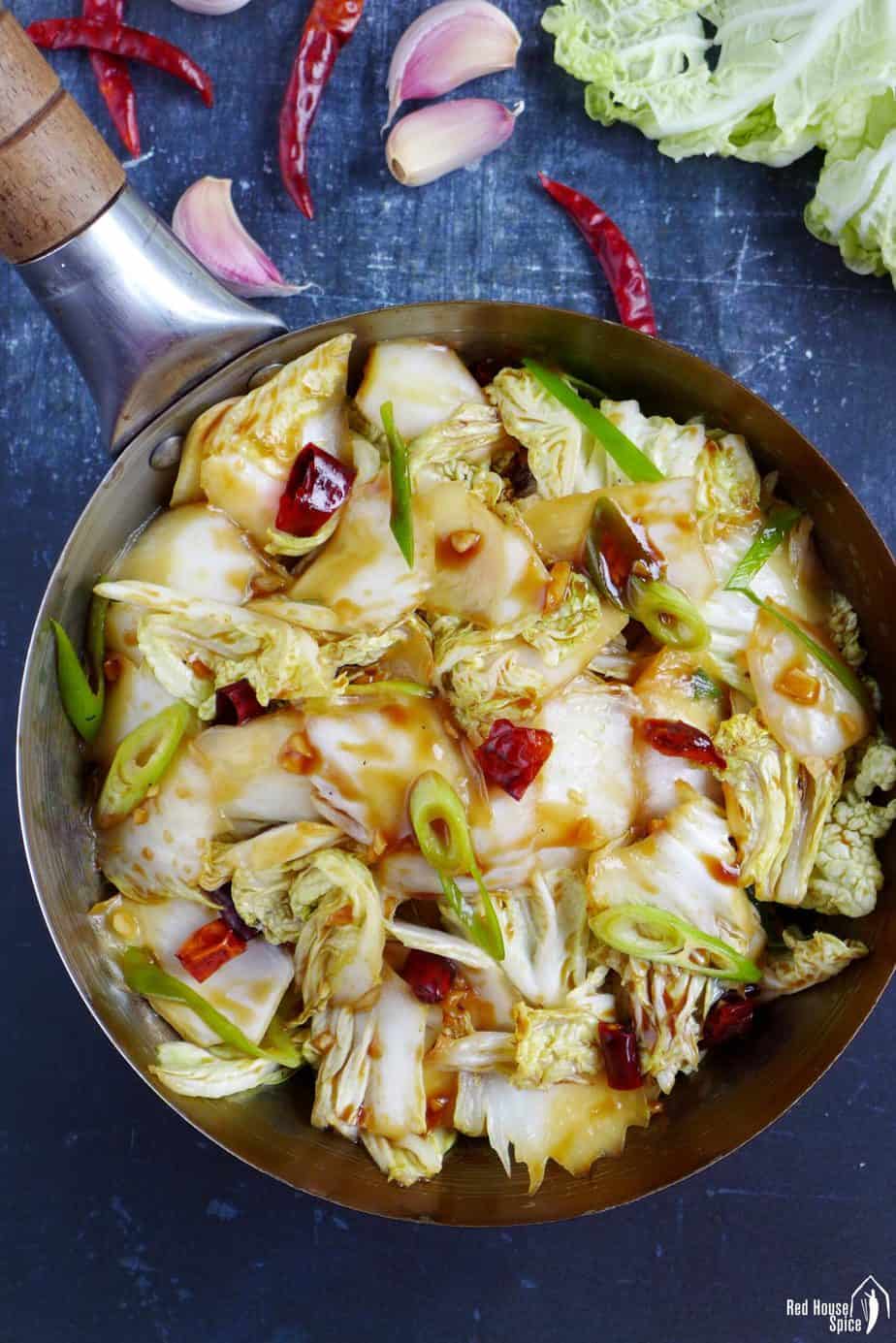
No doubt that this is a very simple stir-fry dish to make. A couple of minutes is all that you need. However, to achieve a restaurant standard (or the best home cook standard) in terms of taste and texture, you would need to have some basic knowledge on the concept of “Huǒ Hóu/火候” in Chinese cuisine. It refers to the control of heat and cooking time which noticeably affects the final result of a dish. It’s particularly important for stir-frying as everything is happening in just a few minutes.
Generally speaking, for this Napa cabbage stir-fry, the heat should be high and the cooking time needs to be as short as possible. This way, the white part of the cabbage remains crunchy and the dish doesn’t look too wet. Here are a few helpful tips:
- Use a carbon steel wok which heats up quickly. It’s essential cookware for authentic Chinese cuisine. So get one if you wish to achieve the best stir-fry result. It’s very versatile too. Many steaming tasks can be done in a wok, for example for making Chinese Steamed Fish.
- Use the most powerful hob you’ve got and keep the heat on high all the time. However, please be careful not to burn the garlic and dried chili at the beginning.
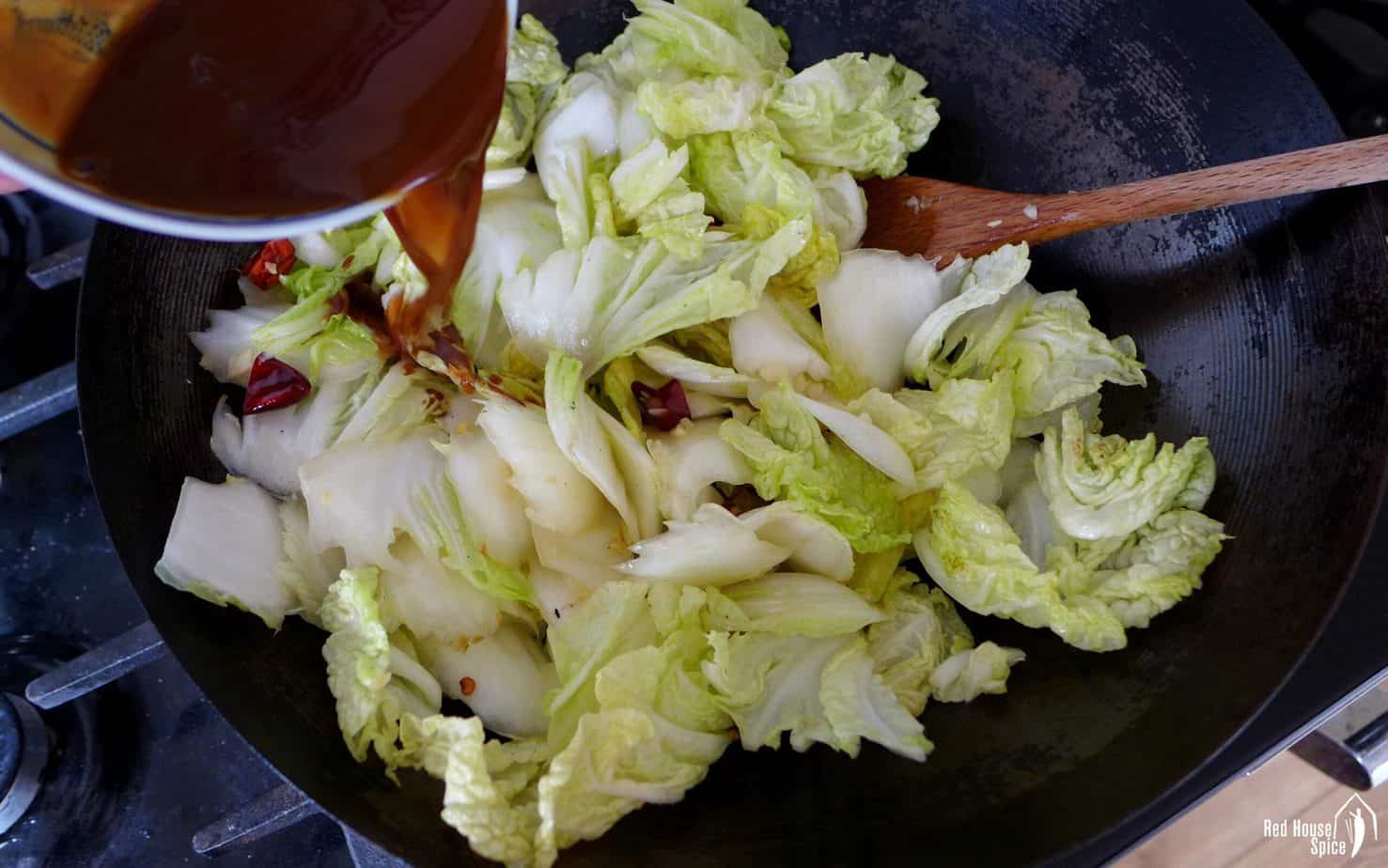
- Have the sauce mixed before you start cooking. This prevents you from prolonging the cooking time unnecessarily by measuring and pouring seasonings one by one during cooking.
- Add the sauce at the very end of the process. Otherwise, the salt in the sauce will extract too much water from the cabbage.
- Do not overcook the cabbage. This is very important. Once you see the light green, leafy part of the cabbage STARTING to wilt, pour in the sauce. At this point, the cabbage pieces may still look a little bulky. By the time the sauce thickens and you transfer the dish to the table, they will reduce quite a lot in size.
Other vegetarian dishes with great flavours

Although everyone in our Red House enjoys eating meat/fish, we often have vegetarian dinners which include multiple dishes and plain rice. You can find other vegetarian recipes on the blog to cook healthy and delicious meals. Here is an example:
- Choose one of the three ways to make a tasty Cucumber Salad
- Use minced shiitake mushroom to replace pork and make classic Mapo Tofu. Or make Pan-fried Tofu with Garlic Sauce
- Stir fry a plate of Eggplant with Plum Sauce
- Make a pot of warming and comforting Egg Drop Soup with Tomato
- Fry some Scallion Pancakes if you fancy a change instead of serving rice
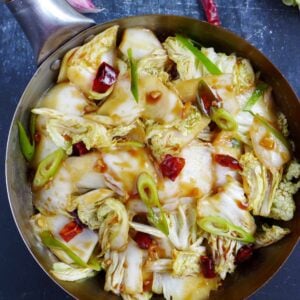
Stir-fried Napa Cabbage with Hot & Sour Sauce (酸辣白菜)
Ingredients
- 1 small Napa cabbage (Chinese cabbage) - about 450 g/1 lbs
For the sauce
- 1½ tablespoon black rice vinegar - see note 1
- 1 tablespoon light soy sauce
- ½ teaspoon dark soy sauce - optional
- 1 tablespoon tapioca starch, or cornstarch
- 1 pinch salt
- 1 pinch sugar
- 1 tablespoon water
For stir-frying
- 1 tablespoon cooking oil
- 4 cloves garlic, minced
- 6 dried chilies, cut in sections - or to taste, see note 2
- 1 stalk scallions, finely chopped
Instructions
Prepare the cabbage
- Separate the leaves of the Napa cabbage. Lay one leaf flat on the chopping board. Cut it into bite-sized pieces at a 30-degree angle (please refer to the image in the post above). Repeat to finish the rest.
Mix the sauce
- In a small bowl, mix black rice vinegar, light soy sauce, dark soy sauce, starch, salt, sugar and water. Set aside.
Stir-fry the dish
- Heat up a wok over high heat until it starts to smoke. Pour in oil then add garlic and dried chilies. Fry until fragrant (do not burn).
- Put in the cabbage. Stir fry until the green leafy part starts to wilt but the white part remains crunchy.
- Give the sauce a good stir then pour into the wok. Add scallions. Mix well. Remove from the heat once the sauce thickens. Serve immediately.
NOTES
NUTRITION
NUTRITION DISCLOSURE: Nutritional information on this website is provided as a courtesy to readers. It should be considered estimates. Please use your own brand nutritional values or your preferred nutrition calculator to double check against our estimates.



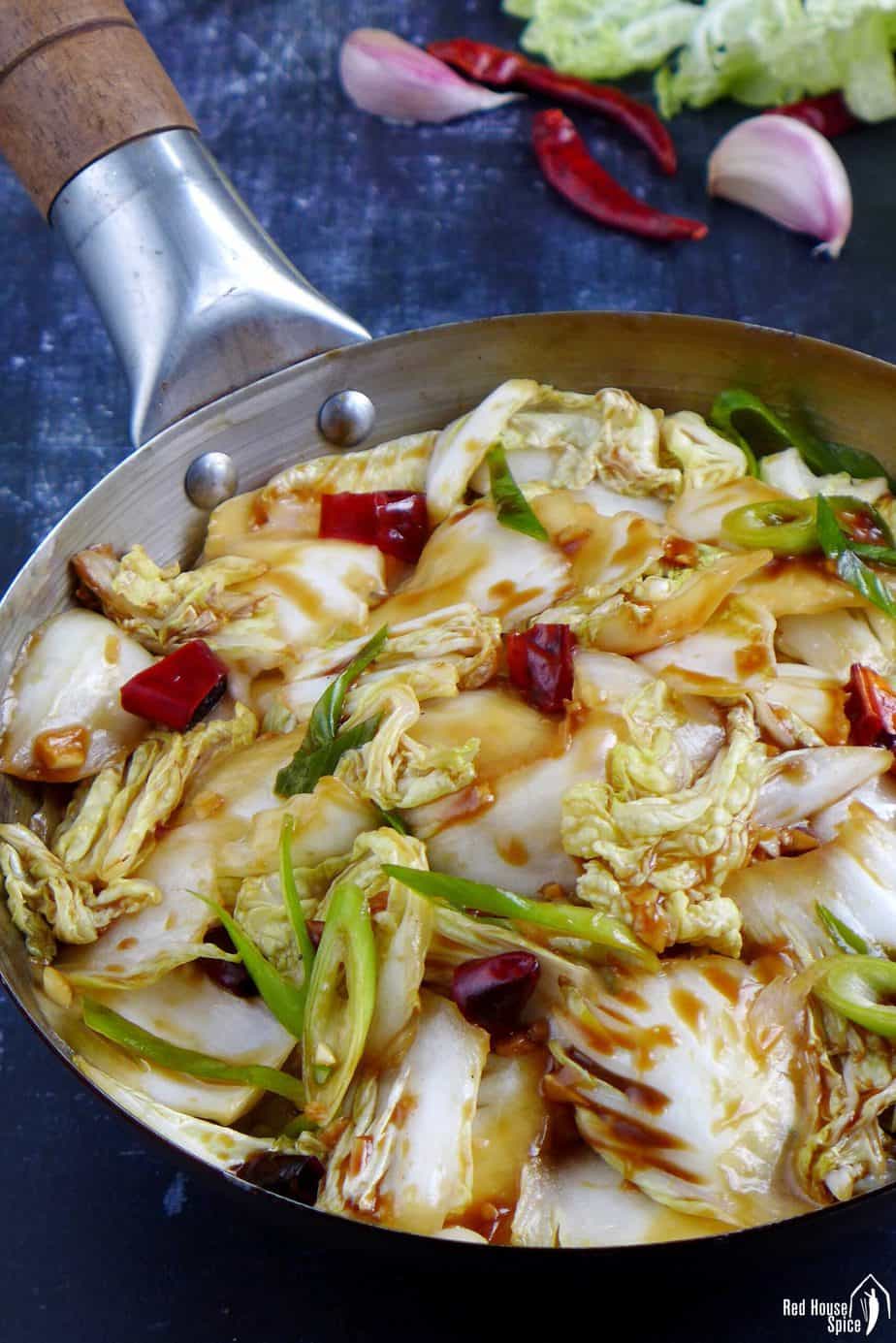

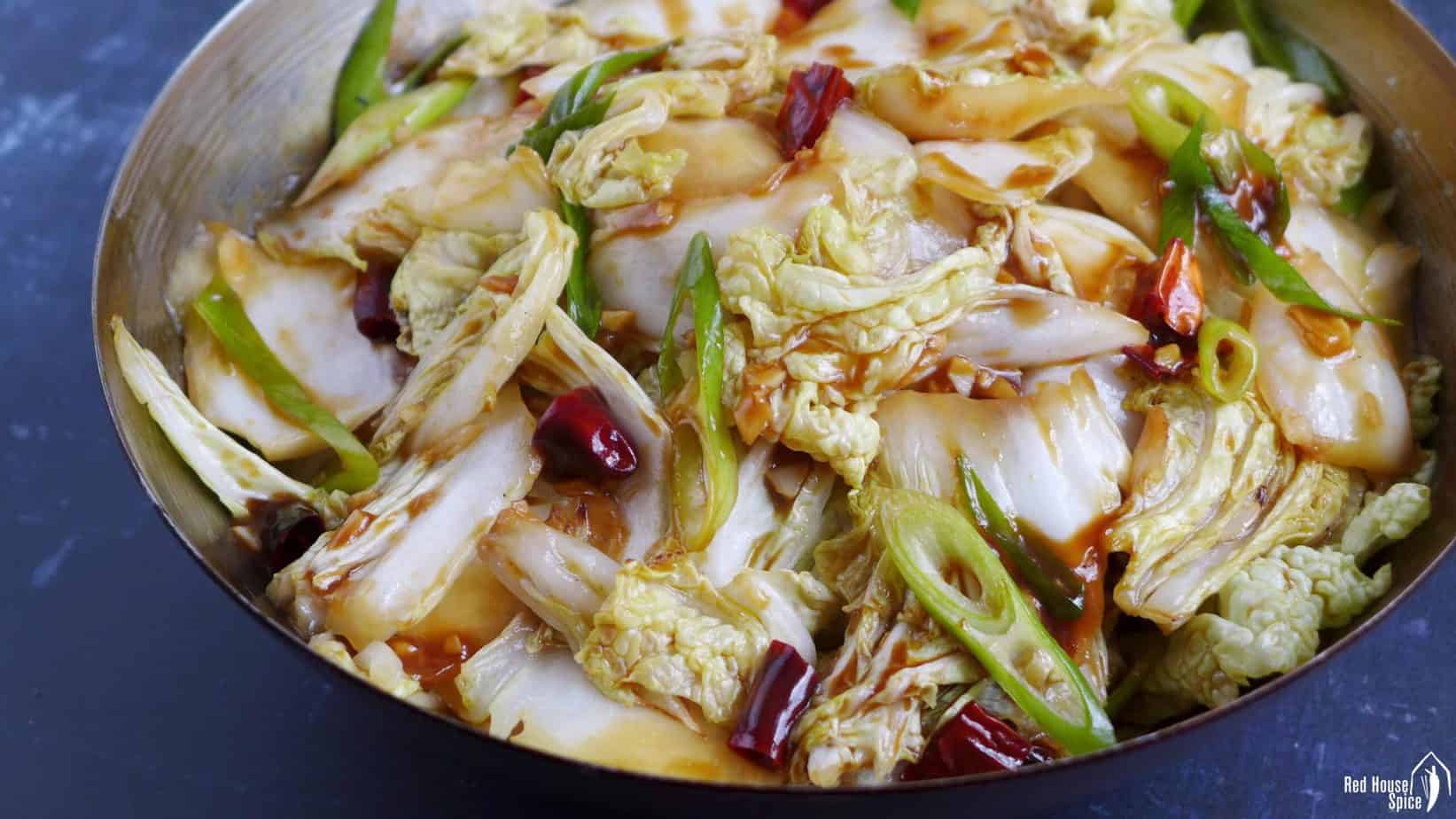
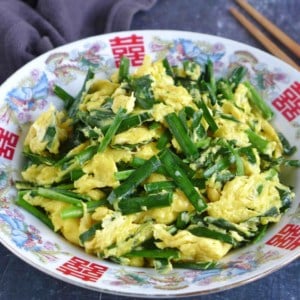
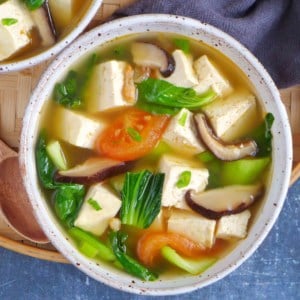
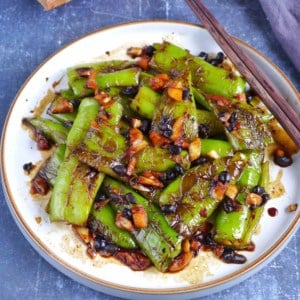
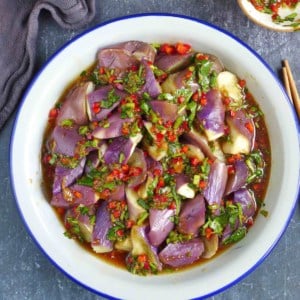
So delicious, I made it as is, except used Thai chili flakes. Maybe the most delicious cabbage ever. Thank you for the recipe
My pleasure to share Raquel! It’s my favorite way to enjoy Napa cabbage too.
I’ve tried this before but a while ago! Tonight I had all the ingredients! As is NZ Pakeha heat tolerance I used only 3 dried chillies and de-seeded them!
Nonetheless, this is a go-to recipe.
Very happy to hear that!
Tonight it is Egg-Fried Rice and Stir-fried Chicken. Both are already in my repeat recipe list!
We loved this dish. Found “lite” soy sauce in non-Asian grocery. Does “light soy sauce” in your recipe refer to “light” in color or “lite” otherwise? 1/2 Tbsp tapioca starch.worked fine. Will use one or two dried chilies next time, definitely not 6. For dessert, slices of fresh mango drizzled with condensed coconut milk complements well.
Glad you enjoyed the dish! Light soy sauce (生抽) refers to soy sauce that’s lighter in colour and consistency than dark soy sauce(老抽). It doesn’t mean low-sodium/less salt soy sauce.